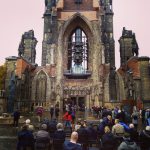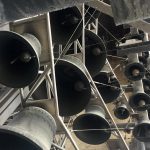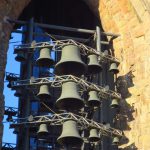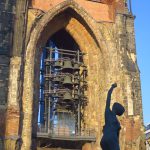Past and present
The first carillon in the St. Nikolai Church was cast by François Hemony in Amsterdam in 1661. It was placed initially in St. Catherine’s Church and moved in 1663 to St. Nicholas’ Church. The instrument vanished in the great city fire on 5 May 1842 while the chimes were playing the hymn Allein Gott in der Höh’ sei Ehr. The construction of the current church was completed in 1882. It contained a carillon of 32 bells from 1888, which was cast in the Belgian bell-foundry of Séverin Van Aerschodt. This carillon was requisitioned for military purposes in 1917.
The church tower was one of the highest in the world, which led to the downfall of the building during the Second World War. The tower of St. Nikolai involuntarily initiated the fall of Hamburg, although the tower itself strangely survived the destruction. When the Allied Air Forces flew their nightly attacks on Hamburg in 1943, they chose the tower of St. Nikolai as a landmark. The event went down in history as “Operation Gomorrah”. The church was never rebuilt but serves as a Memorial for the victims of war and tyranny of the years 1933-1945.
In September 1992 the association “Rettet die Nikolaikirche” e.V. (‘Save the St. Nikolai Church’) launched an appeal for donations for the installation of a carillon in the steeple of the church ruins of St. Nikolai. The willingness to donate was so great that by November 1992 the first of the 51 bells could be cast by the Eijsbouts company in the Netherlands. After all bells were cast, one of them was brought to Rome, where it received the Papal blessing.
On 23 June 1993 all the bells were put on a flatbed truck and driven from the Netherlands to Hamburg. Before their journey began, they were blessed by Catholic, Protestant and Muslim clergymen, in a joint ceremony. The installation of the bells was completed on 28 June, in time for the first concert on 24 July 1993. The inauguration marked 50 years after ‘Operation Gomorrah’ as a call for peace and reconciliation. Today the carillon is used for weekly live concerts, summer recitals, special events, and commemorations.
Facts and figures
| Number of bells | 51 |
| Total weight of the bells | ca. 13,000 kg |
| Weight of the bourdon | 2002 kg |
| Pitch of bourdon | c1, connected to c in the keyboard |
| Bell founder | Eijsbouts 1992 |
| Manual playing system | mechanical baton-type keyboard |
| Automatic playing system | Midi system with pneumatic pistons |
| Carillonneurs | Werner Lamm, Gudrun Schmidtke |
| Regular recitals | Thursdays from 12 to 12.30 pm |
| Summer concerts | yes (no fixed days) |
| Accessibility of the tower | none; the carillon can be seen from the site of the Memorial. |
Significant inscription
Tu deinen Mund auf für die Stummen!
Speak up for the mute!
(inscription on the bourdon, from Luther Bible, Sprüche 31,8)



